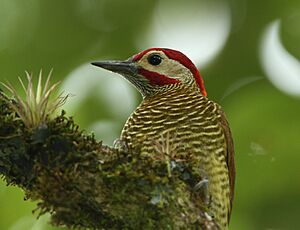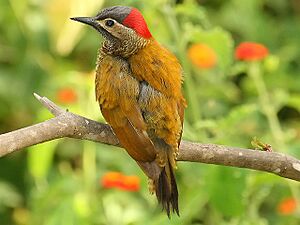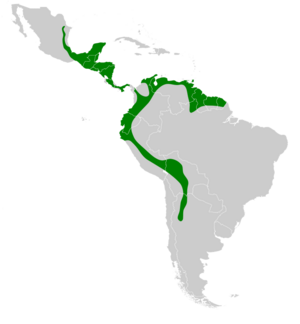Golden-olive woodpecker facts for kids
Quick facts for kids Golden-olive woodpecker |
|
|---|---|
 |
|
 |
|
| Male above, female below | |
| Conservation status | |
| Scientific classification | |
| Genus: |
Colaptes
|
| Species: |
rubiginosus
|
 |
|
| Synonyms | |
|
|
The golden-olive woodpecker (Colaptes rubiginosus) is a colorful bird from the woodpecker family. You can find it in many places, from Mexico all the way south and east through Panama. It also lives in almost every country in mainland South America, except for Chile, Paraguay, and Uruguay. You can even spot it on the islands of Trinidad and Tobago!
Contents
About This Woodpecker
Scientists like to organize living things into groups. This is called taxonomy. The golden-olive woodpecker was first named the "brown woodpecker." Over time, scientists learned more about it and moved it into a different group, or genus, called Colaptes.
There are many different types, or subspecies, of the golden-olive woodpecker. Different bird organizations sometimes count them slightly differently. For example, the International Ornithological Committee (IOC) and BirdLife International recognize 18 subspecies. These are like different versions of the same bird, often found in different areas.
- C. r. yucatanensis (Cabot, S., 1844)
- C. r. alleni (Bangs, 1902)
- C. r. buenavistae (Chapman, 1915)
- C. r. meridensis (Ridgway, 1911)
- C. r. rubiginosus (Swainson, 1820)
- C. r. deltanus (Aveledo & Ginés, 1953)
- C. r. paraquensis (Phelps, W.H. & Phelps, W.H. Jr., 1948)
- C. r. guianae (Hellmayr, 1918)
- C. r. viridissimus (Chapman, 1939)
- C. r. nigriceps (Blake, 1941)
- C. r. trinitatis (Ridgway, 1911)
- C. r. tobagensis (Ridgway, 1911)
- C. r. gularis (Hargitt, 1889)
- C. r. rubripileus (Salvadori & Festa, 1900)
- C. r. coloratus (Chapman, 1923)
- C. r. chrysogaster (Berlepsch & Stolzmann, 1902)
- C. r. canipileus (d'Orbigny, 1840)
- C. r. tucumanus (Cabanis, 1883)
The name rubiginosus means "full of rust." This describes the rusty color on the bird's wings and back.
What Does It Look Like?
The golden-olive woodpecker is about 18 to 23 centimeters (7 to 9 inches) long. Males and females look very similar, but their heads have some differences.
Male golden-olive woodpeckers have a gray forehead and the top of their head. They also have a red border and red on the back of their neck. They have a wide red stripe on their cheek.
Female golden-olive woodpeckers only have red on the back of their neck. Their cheek area has streaks, similar to their throat.
Both male and female birds have mostly green upper parts with a bronze shine. Their tail is brown. Their belly and chest are pale yellow with dark, thin stripes. They have a dark gray or black beak, red eyes, and gray legs. Young woodpeckers are usually duller in color than adult birds.
The different subspecies of golden-olive woodpeckers can vary in size and the exact colors of their backs and bellies. For example, some might have a brighter yellow-green back, while others have more bronze.
Where Does It Live?
The golden-olive woodpecker lives in many different places across its wide range. Each subspecies is found in specific areas:
- C. r. yucatanensis, from Oaxaca and Veracruz in Mexico through Belize, Guatemala, Honduras, El Salvador, Nicaragua, and Costa Rica into western Panama
- C. r. alleni, Colombia's Sierra Nevada de Santa Marta and nearby
- C. r. buenavistae, the eastern Andes of Colombia and Ecuador
- C. r. meridensis, Venezuela's Serranía del Perijá, western Coastal Range, and Andes
- C. r. rubiginosus, north-central and northeastern Venezuelan mountains
- C. r. deltanus, northeastern Venezuela's Delta Amacuro state
- C. r. paraquensis, the tepuis of south-central Venezuela
- C. r. guianae, the tepuis of eastern Venezuela and western Guyana
- C. r. viridissimus, Auyán-tepui in southeastern Venezuela
- C. r. nigriceps, the Acarai Mountains of southern Guyana and southern Suriname
- C. r. trinitatis, Trinidad
- C. r. tobagensis, Tobago
- C. r. gularis, Colombia's Cordillera Occidental and Cordillera Central
- C. r. rubripileus, from southwestern Colombia through western Ecuador to Peru's Department of Lambayeque
- C. r. coloratus, from the Cordillera del Cóndor in extreme southeastern Ecuador into north-central Peru to Department of San Martín
- C. r. chrysogaster, between the departments of Huánuco and Cuzco in central Peru
- C. r. canipileus, from southern Peru into central and southeastern Bolivia
- C. r. tucumanus, from southern Bolivia south to Tucumán Province in Argentina
These woodpeckers can live in many different environments. They are found in dry areas with thorny bushes, and also in wet rainforests. They also live in cloudforests, pine and oak woodlands, and dry forests. You might see them along the edges of forests or in areas with scattered trees, and even in coffee farms where trees provide shade.
They live at different heights above sea level depending on the country. In Mexico, they can be found up to 2,100 meters (6,900 feet) high. In parts of South America, they can live from sea level up to 3,100 meters (10,200 feet).
Behavior and Life Cycle
Movement
Golden-olive woodpeckers usually stay in the same area all year round. They don't migrate to different places.
Feeding Habits
This woodpecker looks for food from the middle of the forest trees all the way up to the very top branches. It explores tree trunks, big branches, and vines. It often hunts alone or in pairs. Sometimes, it joins groups of different bird species looking for food together.
It finds its food by pecking, hammering, and poking into wood. It mostly eats ants, termites, and beetles that bore into wood, along with their young (larvae). It also eats some fruits and berries. Interestingly, it has been seen eating special growths called Müllerian bodies, which some plants produce to feed ants in a helpful partnership.
Reproduction
The breeding season for the golden-olive woodpecker changes depending on where it lives. In Mexico and Colombia, they breed between January and May. In Ecuador and Peru, it's from December or January to July.
They make their nests by digging a hole in a living or dead tree or palm. These nests can be anywhere from 1.2 to 18 meters (4 to 59 feet) above the ground. Both the male and female woodpeckers take turns sitting on the eggs. They usually lay two to four eggs. After the chicks hatch, both parents feed them by bringing up food from their stomachs. The young birds stay in the nest for about 24 days before they are ready to fly.
Sounds and Calls
The golden-olive woodpecker has a special song that sounds like a long, rattling trill that gets louder. It also makes other sounds, like a loud, clear "dree," a sharp "deeeeh," or a "kyown." Sometimes, it makes sounds like "churr, choo-úr" or a liquid "woick-woick-woick."
Like other woodpeckers, it also drums on trees. Its drumming sounds like very short rolls, sometimes repeated quickly. Other times, it's just clear, separate taps.
Conservation Status
The IUCN (International Union for Conservation of Nature) has listed the golden-olive woodpecker as a species of "Least Concern." This means that it is not currently in danger of disappearing. It lives across a very large area, but scientists don't know exactly how many there are, and they believe the number might be slowly going down.
However, there are no immediate threats to this bird. It is quite common in most places where it lives and can be found in many protected areas. Because it can live in so many different types of wooded places, its future seems safe for now.


